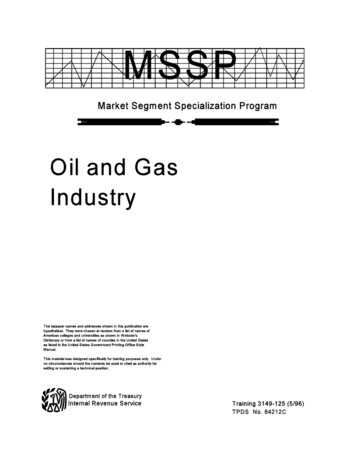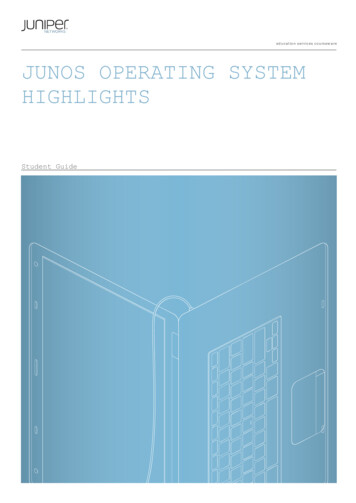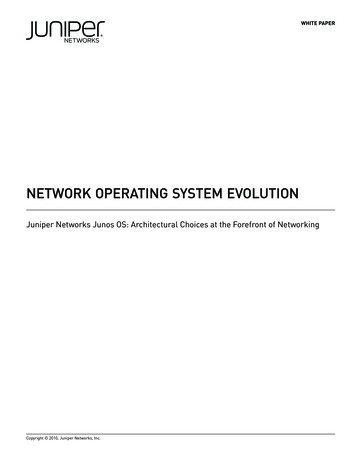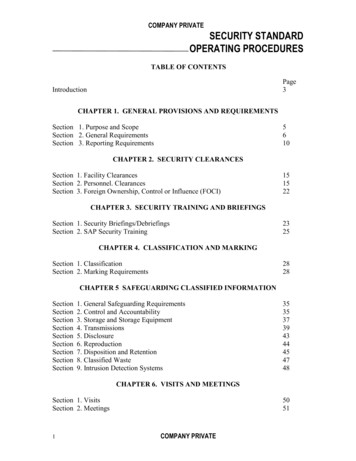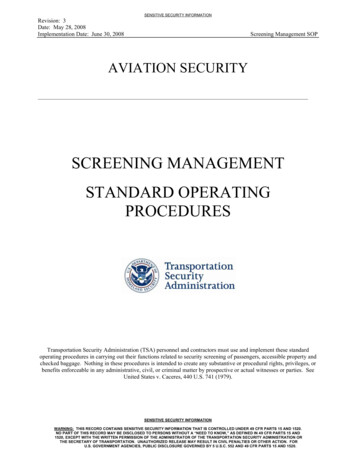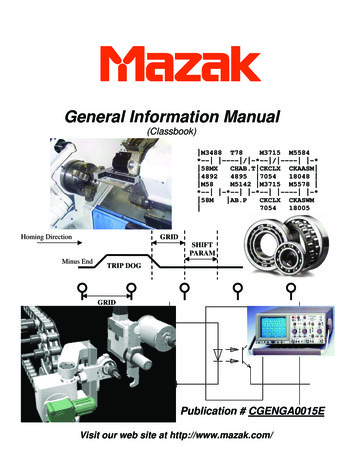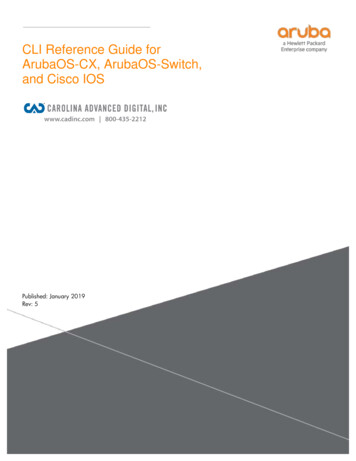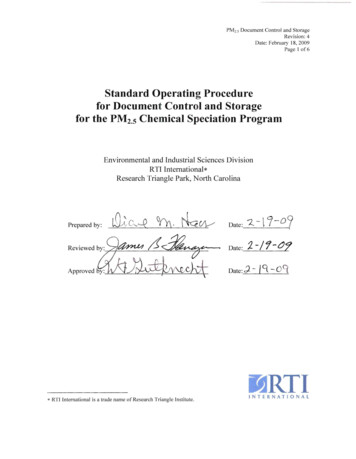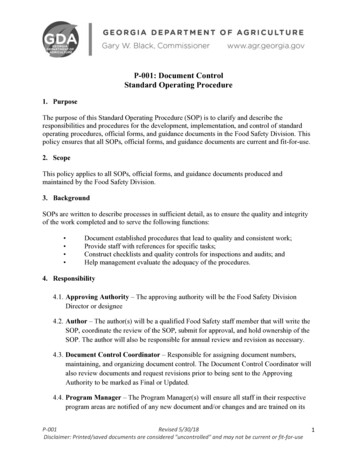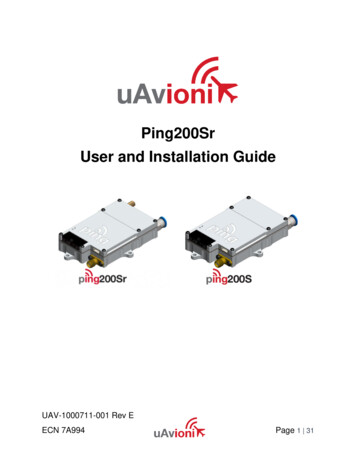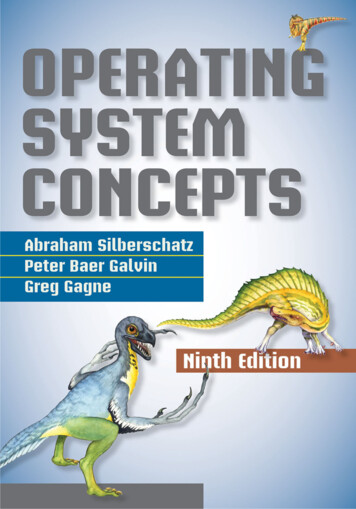
Transcription
OPERATINGSYSTEMCONCEPTSNINTH EDITION
OPERATINGSYSTEMCONCEPTSABRAHAM SILBERSCHATZYale UniversityPETER BAER GALVINPluribus NetworksGREG GAGNEWestminster CollegeNINTH EDITION
Vice President and Executive Publisher Don Fowley Executive Editor Beth Lang Golub Editorial Assistant Katherine Willis Executive Marketing Manager Christopher Ruel Senior Production Editor Ken Santor Cover and title page illustrations Susan Cyr Cover Designer Madelyn Lesure Text Designer Judy Allan This book was set in Palatino by the author using LaTeX and printed and bound by Courier Kendallville. The cover was printed by Courier. Copyright 2013, 2012, 2008 John Wiley & Sons, Inc. All rights reserved. No part of this publication may be reproduced, stored in a retrieval system or transmitted in any form or by any means, electronic, mechanical, photocopying, recording, scanning or otherwise, except as permitted under Sections 107 or 108 of the 1976 United States Copyright Act, without either the prior written permission of the Publisher, or authorization through payment of the appropriate per copy fee to the Copyright Clearance Center, Inc. 222 Rosewood Drive, Danvers, MA 01923, (978)750 8400, fax (978)750 4470. Requests to the Publisher for permission should be addressed to the Permissions Department, John Wiley & Sons, Inc., 111 River Street, Hoboken, NJ 07030 (201)748 6011, fax (201)748 6008, E Mail: PERMREQ@WILEY.COM. Evaluation copies are provided to qualified academics and professionals for review purposes only, for use in their courses during the next academic year. These copies are licensed and may not be sold or transferred to a third party. Upon completion of the review period, please return the evaluation copy to Wiley. Return instructions and a free of charge return shipping label are available at www.wiley.com/go/evalreturn. Outside of the United States, please contact your local representative. Founded in 1807, John Wiley & Sons, Inc. has been a valued source of knowledge and understanding for more than 200 years, helping people around the world meet their needs and fulfill their aspirations. Our company is built on a foundation of principles that include responsibility to the communities we serve and where we live and work. In 2008, we launched a Corporate Citizenship Initiative, a global effort to address the environmental, social, economic, and ethical challenges we face in our business. Among the issues we are addressing are carbon impact, paper specifications and procurement, ethical conduct within our business and among our vendors, and community and charitable support. For more information, please visit our website: www.wiley.com/go/citizenship. ISBN: 978 1 118 06333 0 ISBN BRV: 978 1 118 12938 8 Printed in the United States of America 10 9 8 7 6 5 4 3 2 1
To my children, Lemor, Sivan, and Aaronand my NicoletteAvi SilberschatzTo Brendan and Ellen,and Barbara, Anne and Harold, and Walter and RebeccaPeter Baer GalvinTo my Mom and Dad,Greg Gagne
PrefaceOperating systems are an essential part of any computer system. Similarly,a course on operating systems is an essential part of any computer scienceeducation. This field is undergoing rapid change, as computers are nowprevalent in virtually every arena of day-to-day life —from embedded devicesin automobiles through the most sophisticated planning tools for governmentsand multinational firms. Yet the fundamental concepts remain fairly clear, andit is on these that we base this book.We wrote this book as a text for an introductory course in operating systemsat the junior or senior undergraduate level or at the first-year graduate level. Wehope that practitioners will also find it useful. It provides a clear description ofthe concepts that underlie operating systems. As prerequisites, we assume thatthe reader is familiar with basic data structures, computer organization, anda high-level language, such as C or Java. The hardware topics required for anunderstanding of operating systems are covered in Chapter 1. In that chapter,we also include an overview of the fundamental data structures that areprevalent in most operating systems. For code examples, we use predominantlyC, with some Java, but the reader can still understand the algorithms withouta thorough knowledge of these languages.Concepts are presented using intuitive descriptions. Important theoreticalresults are covered, but formal proofs are largely omitted. The bibliographicalnotes at the end of each chapter contain pointers to research papers in whichresults were first presented and proved, as well as references to recent materialfor further reading. In place of proofs, figures and examples are used to suggestwhy we should expect the result in question to be true.The fundamental concepts and algorithms covered in the book are oftenbased on those used in both commercial and open-source operating systems.Our aim is to present these concepts and algorithms in a general setting thatis not tied to one particular operating system. However, we present a largenumber of examples that pertain to the most popular and the most innovativeoperating systems, including Linux, Microsoft Windows, Apple Mac OS X, andSolaris. We also include examples of both Android and iOS, currently the twodominant mobile operating systems.The organization of the text reflects our many years of teaching courses onoperating systems, as well as curriculum guidelines published by the IEEEvii
viiiPrefaceComputing Society and the Association for Computing Machinery (ACM).Consideration was also given to the feedback provided by the reviewers ofthe text, along with the many comments and suggestions we received fromreaders of our previous editions and from our current and former students.Content of This BookThe text is organized in eight major parts: Overview. Chapters 1 and 2 explain what operating systems are, whatthey do, and how they are designed and constructed. These chaptersdiscuss what the common features of an operating system are and what anoperating system does for the user. We include coverage of both traditionalPC and server operating systems, as well as operating systems for mobiledevices. The presentation is motivational and explanatory in nature. Wehave avoided a discussion of how things are done internally in thesechapters. Therefore, they are suitable for individual readers or for studentsin lower-level classes who want to learn what an operating system iswithout getting into the details of the internal algorithms. Process management. Chapters 3 through 7 describe the process conceptand concurrency as the heart of modern operating systems. A processis the unit of work in a system. Such a system consists of a collectionof concurrently executing processes, some of which are operating-systemprocesses (those that execute system code) and the rest of which are userprocesses (those that execute user code). These chapters cover methods forprocess scheduling, interprocess communication, process synchronization,and deadlock handling. Also included is a discussion of threads, as wellas an examination of issues related to multicore systems and parallelprogramming. Memory management. Chapters 8 and 9 deal with the management ofmain memory during the execution of a process. To improve both theutilization of the CPU and the speed of its response to its users, thecomputer must keep several processes in memory. There are many differentmemory-management schemes, reflecting various approaches to memorymanagement, and the effectiveness of a particular algorithm depends onthe situation. Storage management. Chapters 10 through 13 describe how mass storage,the file system, and I/O are handled in a modern computer system. Thefile system provides the mechanism for on-line storage of and accessto both data and programs. We describe the classic internal algorithmsand structures of storage management and provide a firm practicalunderstanding of the algorithms used —their properties, advantages, anddisadvantages. Since the I/O devices that attach to a computer vary widely,the operating system needs to provide a wide range of functionality toapplications to allow them to control all aspects of these devices. Wediscuss system I/O in depth, including I/O system design, interfaces, andinternal system structures and functions. In many ways, I/O devices arethe slowest major components of the computer. Because they represent a
Prefaceixperformance bottleneck, we also examine performance issues associatedwith I/O devices. Protection and security. Chapters 14 and 15 discuss the mechanismsnecessary for the protection and security of computer systems. Theprocesses in an operating system must be protected from one another’sactivities, and to provide such protection, we must ensure that onlyprocesses that have gained proper authorization from the operating systemcan operate on the files, memory, CPU, and other resources of the system.Protection is a mechanism for controlling the access of programs, processes,or users to computer-system resources. This mechanism must provide ameans of specifying the controls to be imposed, as well as a means ofenforcement. Security protects the integrity of the information stored inthe system (both data and code), as well as the physical resources of thesystem, from unauthorized access, malicious destruction or alteration, andaccidental introduction of inconsistency. Advanced topics. Chapters 16 and 17 discuss virtual machines anddistributed systems. Chapter 16 is a new chapter that provides an overviewof virtual machines and their relationship to contemporary operatingsystems. Included is an overview of the hardware and software techniquesthat make virtualization possible. Chapter 17 condenses and updates thethree chapters on distributed computing from the previous edition. Thischange is meant to make it easier for instructors to cover the material inthe limited time available during a semester and for students to gain anunderstanding of the core ideas of distributed computing more quickly. Case studies. Chapters 18 and 19 in the text, along with Appendices A andB (which are available on (http://www.os-book.com), present detailedcase studies of real operating systems, including Linux, Windows 7,FreeBSD, and Mach. Coverage of both Linux and Windows 7 are presentedthroughout this text; however, the case studies provide much more detail.It is especially interesting to compare and contrast the design of these twovery different systems. Chapter 20 briefly describes a few other influentialoperating systems.The Ninth EditionAs we wrote this Ninth Edition of Operating System Concepts, we were guidedby the recent growth in three fundamental areas that affect operating systems:1. Multicore systems2. Mobile computing3. VirtualizationTo emphasize these topics, we have integrated relevant coverage throughoutthis new edition—and, in the case of virtualization, have written an entirelynew chapter. Additionally, we have rewritten material in almost every chapterby bringing older material up to date and removing material that is no longerinteresting or relevant.
xPrefaceWe have also made substantial organizational changes. For example, wehave eliminated the chapter on real-time systems and instead have integratedappropriate coverage of these systems throughout the text. We have reorderedthe chapters on storage management and have moved up the presentationof process synchronization so that it appears before process scheduling. Mostof these organizational changes are based on our experiences while teachingcourses on operating systems.Below, we provide a brief outline of the major changes to the variouschapters: Chapter 1, Introduction, includes updated coverage of multiprocessorand multicore systems, as well as a new section on kernel data structures.Additionally, the coverage of computing environments now includesmobile systems and cloud computing. We also have incorporated anoverview of real-time systems. Chapter 2, Operating-System Structures, provides new coverage of userinterfaces for mobile devices, including discussions of iOS and Android,and expanded coverage of Mac OS X as a type of hybrid system. Chapter 3, Processes, now includes coverage of multitasking in mobileoperating systems, support for the multiprocess model in Google’s Chromeweb browser, and zombie and orphan processes in UNIX. Chapter 4, Threads, supplies expanded coverage of parallelism andAmdahl’s law. It also provides a new section on implicit threading,including OpenMP and Apple’s Grand Central Dispatch. Chapter 5, Process Synchronization (previously Chapter 6), adds a newsection on mutex locks as well as coverage of synchronization usingOpenMP, as well as functional languages. Chapter 6, CPU Scheduling (previously Chapter 5), contains new coverageof the Linux CFS scheduler and Windows user-mode scheduling. Coverageof real-time scheduling algorithms has also been integrated into thischapter. Chapter 7, Deadlocks, has no major changes. Chapter 8, Main Memory, includes new coverage of swapping on mobilesystems and Intel 32- and 64-bit architectures. A new section discussesARM architecture. Chapter 9, Virtual Memory, updates kernel memory management toinclude the Linux SLUB and SLOB memory allocators. Chapter 10, Mass-Storage Structure (previously Chapter 12), adds coverage of solid-state disks. Chapter 11, File-System Interface (previously Chapter 10), is updatedwith information about current technologies. Chapter 12, File-System Implementation (previously Chapter 11), isupdated with coverage of current technologies. Chapter 13, I/O, updates technologies and performance numbers, expandscoverage of synchronous/asynchronous and blocking/nonblocking I/O,and adds a section on vectored I/O.
Prefacexi Chapter 14, Protection, has no major changes. Chapter 15, Security, has a revised cryptography section with modernnotation and an improved explanation of various encryption methods andtheir uses. The chapter also includes new coverage of Windows 7 security. Chapter 16, Virtual Machines, is a new chapter that provides an overviewof virtualization and how it relates to contemporary operating systems. Chapter 17, Distributed Systems, is a new chapter that combines andupdates a selection of materials from previous Chapters 16, 17, and 18. Chapter 18, The Linux System (previously Chapter 21), has been updatedto cover the Linux 3.2 kernel. Chapter 19, Windows 7, is a new chapter presenting a case study ofWindows 7. Chapter 20, Influential Operating Systems (previously Chapter 23), hasno major changes.Programming EnvironmentsThis book uses examples of many real-world operating systems to illustratefundamental operating-system concepts. Particular attention is paid to Linuxand Microsoft Windows, but we also refer to various versions of UNIX(including Solaris, BSD, and Mac OS X).The text also provides several example programs written in C andJava. These programs are intended to run in the following programmingenvironments: POSIX. POSIX (which stands for Portable Operating System Interface) represents a set of standards implemented primarily for UNIX-based operatingsystems. Although Windows systems can also run certain POSIX programs,our coverage of POSIX focuses on UNIX and Linux systems. POSIX-compliantsystems must implement the POSIX core standard (POSIX.1); Linux, Solaris,and Mac OS X are examples of POSIX-compliant systems. POSIX alsodefines several extensions to the standards, including real-time extensions(POSIX1.b) and an extension for a threads library (POSIX1.c, better knownas Pthreads). We provide several programming examples written in Cillustrating the POSIX base API, as well as Pthreads and the extensions forreal-time programming. These example programs were tested on Linux 2.6and 3.2 systems, Mac OS X 10.7, and Solaris 10 using the gcc 4.0 compiler. Java. Java is a widely used programming language with a richAPI andbuilt-in language support for thread creation and management. Javaprograms run on any operating system supporting a Java virtual machine(or JVM). We illustrate various operating-system and networking conceptswith Java programs tested using the Java 1.6 JVM. Windows systems. The primary programming environment for Windowssystems is the Windows API, which provides a comprehensive set of functions for managing processes, threads, memory, and peripheral devices.We supply several C programs illustrating the use of this API. Programswere tested on systems running Windows XP and Windows 7.
xiiPrefaceWe have chosen these three programming environments because webelieve that they best represent the two most popular operating-system models—Windows and UNIX/Linux—along with the widely used Java environment.Most programming examples are written in C, and we expect readers to becomfortable with this language. Readers familiar with both the C and Javalanguages should easily understand most programs provided in this text.In some instances—such as thread creation—we illustrate a specificconcept using all three programming environments, allowing the readerto contrast the three different libraries as they address the same task. Inother situations, we may use just one of the APIs to demonstrate a concept.For example, we illustrate shared memory using just the POSIX API; socketprogramming in TCP/IP is highlighted using the Java API.Linux Virtual MachineTo help students gain a better understanding of the Linux system, weprovide a Linux virtual machine, including the Linux source code,that is available for download from the the website supporting thistext (http://www.os-book.com). This virtual machine also includes agcc development environment with compilers and editors. Most of theprogramming assignments in the book can be completed on this virtualmachine, with the exception of assignments that require Java or the WindowsAPI.We also provide three programming assignments that modify the Linuxkernel through kernel modules:1. Adding a basic kernel module to the Linux kernel.2. Adding a kernel module that uses various kernel data structures.3. Adding a kernel module that iterates over tasks in a running Linuxsystem.Over time it is our intention to add additional kernel module assignments onthe supporting website.Supporting WebsiteWhen you visit the website supporting this text at http://www.os-book.com,you can download the following resources: Linux virtual machineC and Java source codeSample syllabiSet of Powerpoint slidesSet of figures and illustrationsFreeBSD and Mach case studies
Prefacexiii Solutions to practice exercises Study guide for students ErrataNotes to InstructorsOn the website for this text, we provide several sample syllabi that suggestvarious approaches for using the text in both introductory and advancedcourses. As a general rule, we encourage instructors to progress sequentiallythrough the chapters, as this strategy provides the most thorough study ofoperating systems. However, by using the sample syllabi, an instructor canselect a different ordering of chapters (or subsections of chapters).In this edition, we have added over sixty new written exercises and overtwenty new programming problems and projects. Most of the new programming assignments involve processes, threads, process synchronization, andmemory management. Some involve adding kernel modules to the Linuxsystem which requires using either the Linux virtual machine that accompaniesthis text or another suitable Linux distribution.Solutions to written exercises and programming assignments are availableto instructors who have adopted this text for their operating-system class. Toobtain these restricted supplements, contact your local John Wiley & Sonssales representative. You can find your Wiley representative by going tohttp://www.wiley.com/college and clicking “Who’s my rep?”Notes to StudentsWe encourage you to take advantage of the practice exercises that appear atthe end of each chapter. Solutions to the practice exercises are available fordownload from the supporting website http://www.os-book.com. We alsoencourage you to read through the study guide, which was prepared by one ofour students. Finally, for students who are unfamiliar with UNIX and Linuxsystems, we recommend that you download and install the Linux virtualmachine that we include on the supporting website. Not only will this provideyou with a new computing experience, but the open-source nature of Linuxwill allow you to easily examine the inner details of this popular operatingsystem.We wish you the very best of luck in your study of operating systems.Contacting UsWe have endeavored to eliminate typos, bugs, and the like from the text. But,as in new releases of software, bugs almost surely remain. An up-to-date erratalist is accessible from the book’s website. We would be grateful if you wouldnotify us of any errors or omissions in the book that are not on the current listof errata.We would be glad to receive suggestions on improvements to the book.We also welcome any contributions to the book website that could be of
xivPrefaceuse to other readers, such as programming exercises, project suggestions,on-line labs and tutorials, and teaching tips. E-mail should be addressed toos-book-authors@cs.yale.edu.AcknowledgmentsThis book is derived from the previous editions, the first three of whichwere coauthored by James Peterson. Others who helped us with previouseditions include Hamid Arabnia, Rida Bazzi, Randy Bentson, David Black,Joseph Boykin, Jeff Brumfield, Gael Buckley, Roy Campbell, P. C. Capon, JohnCarpenter, Gil Carrick, Thomas Casavant, Bart Childs, Ajoy Kumar Datta,Joe Deck, Sudarshan K. Dhall, Thomas Doeppner, Caleb Drake, M. RacsitEskicioğlu, Hans Flack, Robert Fowler, G. Scott Graham, Richard Guy, MaxHailperin, Rebecca Hartman, Wayne Hathaway, Christopher Haynes, DonHeller, Bruce Hillyer, Mark Holliday, Dean Hougen, Michael Huang, AhmedKamel, Morty Kewstel, Richard Kieburtz, Carol Kroll, Morty Kwestel, ThomasLeBlanc, John Leggett, Jerrold Leichter, Ted Leung, Gary Lippman, CarolynMiller, Michael Molloy, Euripides Montagne, Yoichi Muraoka, Jim M. Ng,Banu Özden, Ed Posnak, Boris Putanec, Charles Qualline, John Quarterman,Mike Reiter, Gustavo Rodriguez-Rivera, Carolyn J. C. Schauble, Thomas P.Skinner, Yannis Smaragdakis, Jesse St. Laurent, John Stankovic, Adam Stauffer,Steven Stepanek, John Sterling, Hal Stern, Louis Stevens, Pete Thomas, DavidUmbaugh, Steve Vinoski, Tommy Wagner, Larry L. Wear, John Werth, JamesM. Westall, J. S. Weston, and Yang XiangRobert Love updated both Chapter 18 and the Linux coverage throughoutthe text, as well as answering many of our Android-related questions. Chapter19 was written by Dave Probert and was derived from Chapter 22 of the EighthEdition of Operating System Concepts. Jonathan Katz contributed to Chapter15. Richard West provided input into Chapter 16. Salahuddin Khan updatedSection 15.9 to provide new coverage of Windows 7 security.Parts of Chapter 17 were derived from a paper by Levy and Silberschatz[1990]. Chapter 18 was derived from an unpublished manuscript by StephenTweedie. Cliff Martin helped with updating the UNIX appendix to coverFreeBSD. Some of the exercises and accompanying solutions were supplied byArvind Krishnamurthy. Andrew DeNicola prepared the student study guidethat is available on our website. Some of the the slides were prepeared byMarilyn Turnamian.Mike Shapiro, Bryan Cantrill, and Jim Mauro answered several Solarisrelated questions, and Bryan Cantrill from Sun Microsystems helped with theZFS coverage. Josh Dees and Rob Reynolds contributed coverage of Microsoft’sNET. The project for POSIX message queues was contributed by John Trono ofSaint Michael’s College in Colchester, Vermont.Judi Paige helped with generating figures and presentation of slides.Thomas Gagne prepared new artwork for this edition. Owen Galvin helpedcopy-edit Chapter 16. Mark Wogahn has made sure that the software to producethis book (LATEX and fonts) works properly. Ranjan Kumar Meher rewrote someof the LATEX software used in the production of this new text.
PrefacexvOur Executive Editor, Beth Lang Golub, provided expert guidance as weprepared this edition. She was assisted by Katherine Willis, who managedmany details of the project smoothly. The Senior Production Editor, Ken Santor,was instrumental in handling all the production details.The cover illustrator was Susan Cyr, and the cover designer was MadelynLesure. Beverly Peavler copy-edited the manuscript. The freelance proofreaderwas Katrina Avery; the freelance indexer was WordCo, Inc.Abraham Silberschatz, New Haven, CT, 2012Peter Baer Galvin, Boston, MA, 2012Greg Gagne, Salt Lake City, UT, 2012
ContentsPART ONEChapter 11.11.21.31.41.51.61.71.8OVERVIEWIntroductionWhat Operating Systems Do 4Computer-System Organization 7Computer-System Architecture 12Operating-System Structure 19Operating-System Operations 21Process Management 24Memory Management 25Storage Management 26Chapter 2PART TWO3.13.23.33.43.5Protection and Security 30Kernel Data Structures 31Computing Environments 35Open-Source Operating SystemsSummary 47Exercises 49Bibliographical Notes 5243Operating-System Structures2.1 Operating-System Services 552.2 User and Operating-SystemInterface 582.3 System Calls 622.4 Types of System Calls 662.5 System Programs 742.6 Operating-System Design andImplementation 75Chapter tem Structure 78Operating-System Debugging 86Operating-System Generation 91System Boot 92Summary 93Exercises 94Bibliographical Notes 101PROCESS MANAGEMENTProcessesProcess Concept 105Process Scheduling 110Operations on Processes 115Interprocess Communication 122Examples of IPC Systems 1303.6 Communication in Client –Server Systems 1363.7 Summary 147Exercises 149Bibliographical Notes 161xvii
xviiiContentsChapter 44.14.24.34.44.5Overview 163Multicore Programming 166Multithreading Models 169Thread Libraries 171Implicit Threading 177Chapter 55.15.25.35.45.55.65.7Monitors 223Synchronization Examples 232Alternative Approaches 238Summary 242Exercises 242Bibliographical Notes 2586.7 Operating-System Examples6.8 Algorithm Evaluation 3006.9 Summary 304Exercises 305Bibliographical Notes 311290DeadlocksPART THREE8.18.28.38.48.58.65.85.95.105.11CPU SchedulingSystem Model 315Deadlock Characterization 317Methods for Handling DeadlocksDeadlock Prevention 323Deadlock Avoidance 327Chapter 8188Process SynchronizationBasic Concepts 261Scheduling Criteria 265Scheduling Algorithms 266Thread Scheduling 277Multiple-Processor Scheduling 278Real-Time CPU Scheduling 283Chapter 77.17.27.37.47.54.6 Threading Issues 1834.7 Operating-System Examples4.8 Summary 191Exercises 191Bibliographical Notes 199Background 203The Critical-Section Problem 206Peterson’s Solution 207Synchronization Hardware 209Mutex Locks 212Semaphores 213Classic Problems ofSynchronization 219Chapter 66.16.26.36.46.56.6Threads3227.6 Deadlock Detection 3337.7 Recovery from Deadlock 3377.8 Summary 339Exercises 339Bibliographical Notes 346MEMORY MANAGEMENTMain MemoryBackground 351Swapping 358Contiguous Memory Allocation 360Segmentation 364Paging 366Structure of the Page Table 3788.7 Example: Intel 32 and 64-bitArchitectures 3838.8 Example: ARM Architecture8.9 Summary 389Exercises 390Bibliographical Notes 394388
ContentsChapter 99.19.29.39.49.59.69.7xixVirtual MemoryBackground 397Demand Paging 401Copy-on-Write 408Page Replacement 409Allocation of Frames 421Thrashing 425Memory-Mapped Files 430PART FOUR9.89.99.109.11Allocating Kernel Memory 436Other Considerations 439Operating-System Examples 445Summary 448Exercises 449Bibliographical Notes 461STORAGE MANAGEMENTChapter 10 Mass-Storage Structure10.1 Overview of Mass-StorageStructure 46710.2 Disk Structure 47010.3 Disk Attachment 47110.4 Disk Scheduling 47210.5 Disk Management 47810.610.710.810.9Swap-Space Management 482RAID Structure 484Stable-Storage Implementation 494Summary 496Exercises 497Bibliographical Notes 501Chapter 11 File-System Interface11.111.211.311.411.5File Concept 503Access Methods 513Directory and Disk StructureFile-System Mounting 526File Sharing 52851511.6 Protection 53311.7 Summary 538Exercises 539Bibliographical Notes 541Chapter 12 File-System Implementation12.112.212.312.412.512.6File-System Structure 543File-System Implementation 546Directory Implementation 552Allocation Methods 553Free-Space Management 561Efficiency and Performance 56412.712.812.912.10Recovery 568NFS 571Example: The WAFL File SystemSummary 580Exercises 581Bibliographical Notes 585Chapter 13 I/O Systems13.113.213.313.413.5Overview 587I/O Hardware 588Application I/O Interface 597Kernel I/O Subsystem 604Transforming I/O Requests toHardware Operations 61113.6 STREAMS 61313.7 Performance 61513.8 Summary 618Exercises 619Bibliographical Notes 621577
xxContentsPART FIVEChapter 14PROTECTION AND SECURITYProtection14.114.214.314.414.5Goals of Protection 625Principles of Protection 626Domain of Protection 627Access Matrix 632Implementation of the AccessMatrix 63614.6 Access Control 639Chapter 1515.115.215.315.415.515.615.7Revocation of Access Rights 640Capability-Based Systems 641Language-Based Protection 644Summary 649Exercises 650Bibliographical Notes 652SecurityThe Security Problem 65715.8 Computer-SecurityProgram Threats 661Classifications 698System and Network Threats 66915.9 An Example: Windows 7 699Cryptography as a Security Tool 674 15.10 Summary 701User Authentication 685Exercises 702Implementing Security Defenses 689Bibliographical Notes 704Firewalling to Protect Systems andNetworks 696PART SIXChapter 1616.116.216.316.416.514.714.814.914.10ADVANCED TOPICSVirtual MachinesOverview 711History 713Benefits and Features 714Building Blocks 717Types of Virtual Machines and TheirImplementations 721Chapter 1716.6 Virtualization and Operating-
The Ninth Edition As we wrote this Ninth Edition of Operating System Concepts, we were guided by the recent growth in three fundamental areas that affect operating systems: 1. Multicore systems 2. Mobile computing 3. Virtualization To emphasize thes
